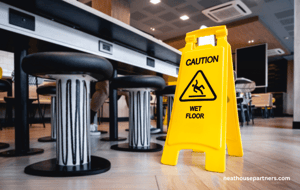Promoting a Culture of Safety: Strategies for Encouraging Employee Buy-in and Engagement
Promoting a Culture of Safety: Strategies for Encouraging Employee Buy-in and Engagement
James Rowland
Commercial Director James leads Account Management, Sales and Marketing at Neathouse Partners.Date
29 May 2023Updated
20 March 2024
Table of contents
Related articles
Tags
As a small business owner, you have a responsibility to keep your employees safe and free from harm whilst they carry out their roles, but safety in the workplace is much more than ticking boxes for compliance or avoiding legal liabilities.
The key to promoting a culture of safety at work comes from effective strategies for employee engagement and buy-in.
Understanding the Importance of Employee Buy-In
Employee buy-in is a fundamental part of creating a strong culture of health and safety within any organisation.
Employee buy-in in this context indicates the level of commitment and involvement an employee has to health and safety, in particular, their willingness to acknowledge and actively participate in upholding the safety guidelines set.
The benefits of this buy-in include:
- Improves Compliance: Employees who understand and agree with health and safety protocols are more likely to follow them consistently.
- Creates a Proactive Safety Culture: Employee buy-in promotes active participation in maintaining safety standards, fostering a culture of collective responsibility.
- Reduces Accidents: With increased awareness and buy-in, employees are more vigilant, reducing the likelihood of accidents and incidents.
- Boosts Employee Engagement and Retention: A strong health and safety culture enhances employee satisfaction, leading to increased engagement and lower turnover rates.
In essence, employee buy-in is essential for a positive, proactive, and productive safety culture. It requires strategic planning and consistent efforts from both leadership and HR to achieve.
Establishing a Safety Culture
Creating a safety culture isn't an overnight task.
It requires consistent communication, training, and engagement from all levels of the organisation.
To help you to set the right culture when it comes to health and safety, we recommend you are proactive in:
- Setting clear expectations: Communicate safety procedures and protocols to ensure everyone understands their importance.
- Providing comprehensive training: Equip your team with the knowledge and skills to implement safety measures correctly.
- Reinforcing safety principles: Regularly remind and reinforce safety practices through success stories, recognition of safe behaviours, and periodic reviews of safety procedures.
- Fostering open communication: Encourage employees to share safety concerns, ideas, and suggestions.
- Leading by example: Demonstrate a strong commitment to safety through your own actions and behaviours.
- Involving employees: Engage employees in decision-making processes related to safety, such as safety audits and risk assessments.
- Recognising and rewarding safety efforts: Acknowledge and reward employees who demonstrate exemplary commitment to safety.
- Continuously improving: Regularly assess and improve safety procedures based on feedback and emerging best practices.
- Emphasising the "why": Communicate the importance of safety, not just for compliance but for the well-being and success of everyone in the organisation.
Further Reading: Health & Safety For Remote Workers
Enhancing Communication for Safety
Clear, consistent, and open communication strengthens trust and fosters a sense of shared responsibility, which is a key strategy for promoting a culture of safety at work.
- One effective strategy is to conduct regular safety talks or meetings where relevant and current safety news within your industry is discussed.
- Use multiple communication channels – team meetings, emails, safety bulletins – to ensure your safety messages reach everyone.
- Sharing real-life examples that illustrate the consequences of a poor safety culture can capture employees' attention and highlight the importance of adhering to safety practices.
- Ensure that your company's safety policy is easily accessible to all employees can facilitate the implementation of safety expectations and best practices, providing a clear framework for safe work completion.
By prioritising open and effective communication, you create an environment where safety is valued, understood, and consistently practised throughout the organisation.
Empowering Employees through Skill Development
Empowering employees through skill development is a crucial strategy for promoting a culture of safety in the workplace.
Skill development programs enhance employees' awareness of safety procedures, protocols, and best practices, enabling them to recognise potential hazards and confidently implement safety measures.
Employees who are equipped with up-to-date knowledge and skills can actively participate in identifying areas for improvement and implementing effective safety measures.
This approach can also generate safety leaders within the organisation, who serve as advocates for safety and influence their peers to prioritise safe practices.
This sense of empowerment can lead to increased engagement and buy-in, reinforcing the safety culture in your organisation.
Involving Employees in Decision Making
Involving employees in decision-making is a powerful strategy that can help to promote a culture of safety in the workplace.
When employees feel included and valued, they develop a sense of ownership and commitment to safety practices.
- Enhanced Commitment: Employee involvement in safety decision-making fosters a deeper commitment to safety practices and demonstrates that their opinions matter.
- Shared Responsibility: Involving employees in audits, assessments, and improvements creates a collaborative environment where everyone contributes to identifying hazards and finding solutions.
- Fresh Insights and Ideas: Employees' day-to-day experiences provide valuable insights that can enhance safety practices and identify areas for improvement.
- Increased Engagement: Inclusion empowers employees, increasing their commitment to safety protocols and active participation in maintaining a safe work environment.
- Improved Communication: Involving employees establishes open and transparent communication channels, enabling the sharing of safety concerns, ideas, and suggestions.
By involving employees in decision-making, organisations harness their knowledge and commitment, fostering a culture of safety where everyone contributes to continuous improvement and a safe work environment.
Implementing Fair HR Policies
Regularly reviewing policies ensures alignment with safety culture and legal obligations.
Here's how implementing and maintaining fair HR policies can contribute to a safer work environment:
- Valuing Every Employee: Fair HR policies communicate that every employee is valued and treated equitably. When employees perceive that they are treated fairly, they are more likely to feel respected and appreciated, which in turn enhances their commitment to safety.
- Increased Buy-in: When employees feel that their concerns and well-being are taken seriously, they are more likely to buy into safety policies and procedures.
- Enhanced Engagement: When employees feel that they are treated fairly, they are more motivated and engaged in their work. This heightened engagement extends to safety practices, as they actively participate in adhering to safety protocols and looking out for the well-being of themselves and their colleagues.
- Consistency and Clarity: Fair HR policies provide clear guidelines and expectations for safety practices. By ensuring consistency in the application of policies, employees have a clear understanding of what is expected of them, leading to improved safety compliance.
- Legal Compliance: Regularly reviewing HR policies ensures they align with safety culture and legal obligations. This helps organisations stay compliant with relevant laws and regulations, avoiding legal issues and potential penalties.
The Legal Perspective: Ensuring Compliance
From a legal standpoint, compliance with health and safety laws is not just important – it's non-negotiable.
A robust safety culture helps you avoid legal issues by promoting proactive compliance.
Summary
By promoting a culture of safety using the strategies outlined above, you can enhance employee buy-in and engagement, safeguard your business legally, and enjoy improved employee well-being and organisational success.
Taking positive steps towards understanding the importance of employee buy-in, establishing a safety culture, enhancing communication for safety, empowering employees through skill development, involving employees in decision-making, implementing fair HR policies, and ensuring legal compliance, will all bring you closer to achieving a culture of safety within your workforce.
Next Steps
Developing and maintaining a safety culture requires ongoing commitment and strategic planning, and at Neathouse Partners, our expert team is equipped to assist you in this process.
Contact us on 01244 893776 to book a free, no-obligation call with one of our experienced team.
Related blog posts

Driving Safety Innovation: The Future of Enhanced Safety for Employers

Ensuring Compliance with Displaying the Health and Safety Law Poster

6 Steps Staff Should Follow After An Accident At Work
Have questions?
Get in touch today
Contact us, and our team will get back to you within 24 hours. We value your questions and are committed to getting them answered quickly.


Hello! I am Nicky
Just fill in the form below with your details, and I will arrange for a member of our team to give you a call.
By clicking, you agree to our Privacy Policy







